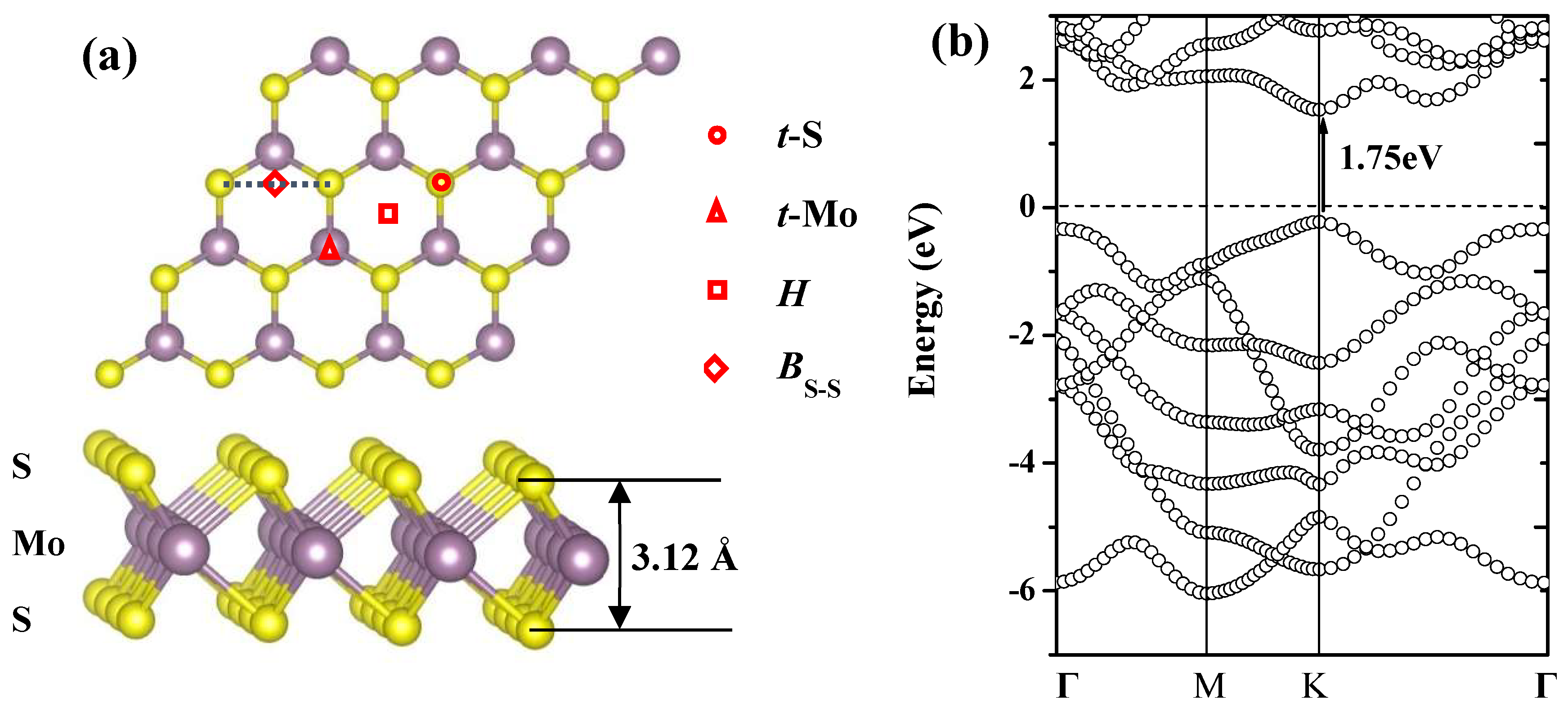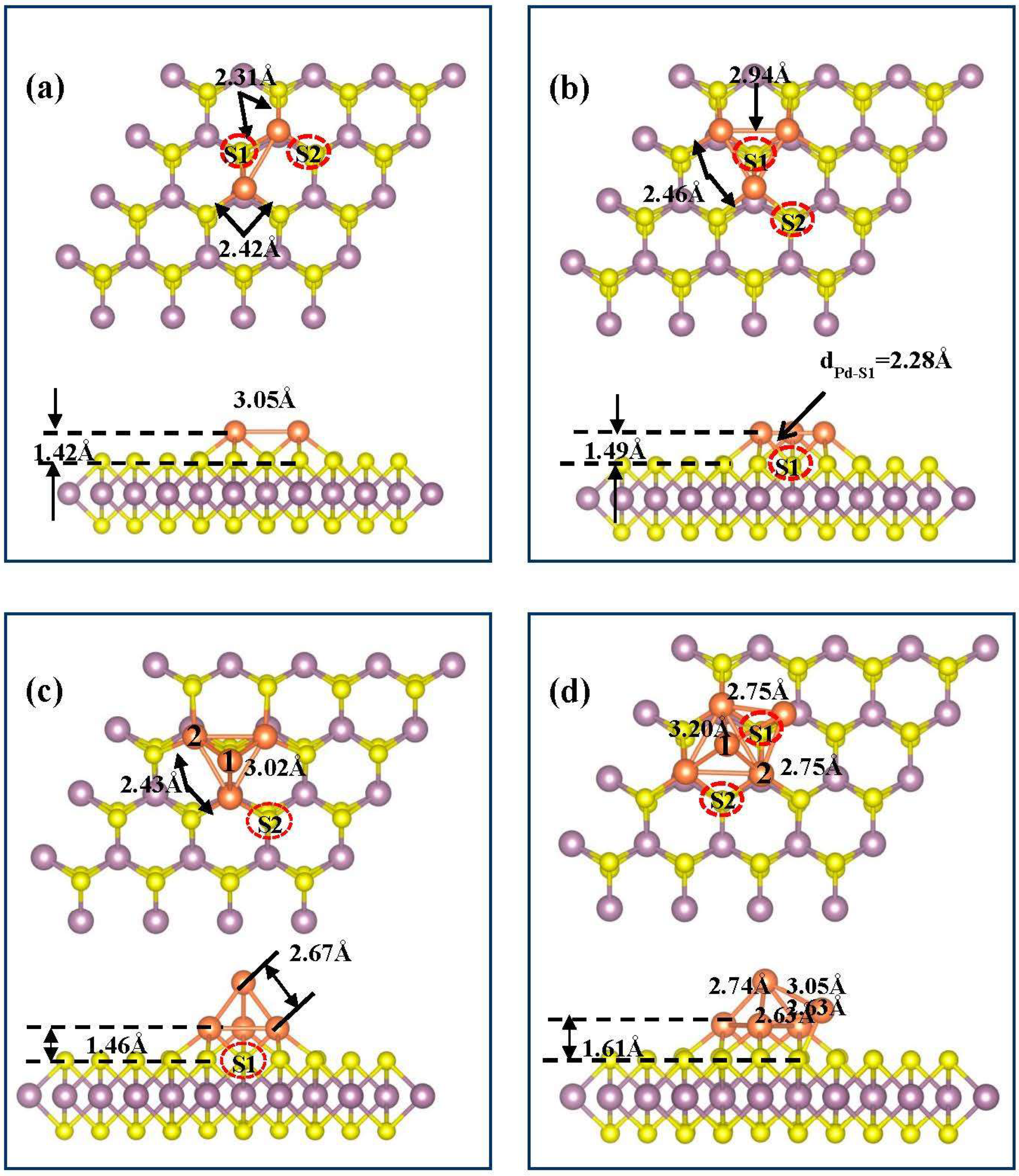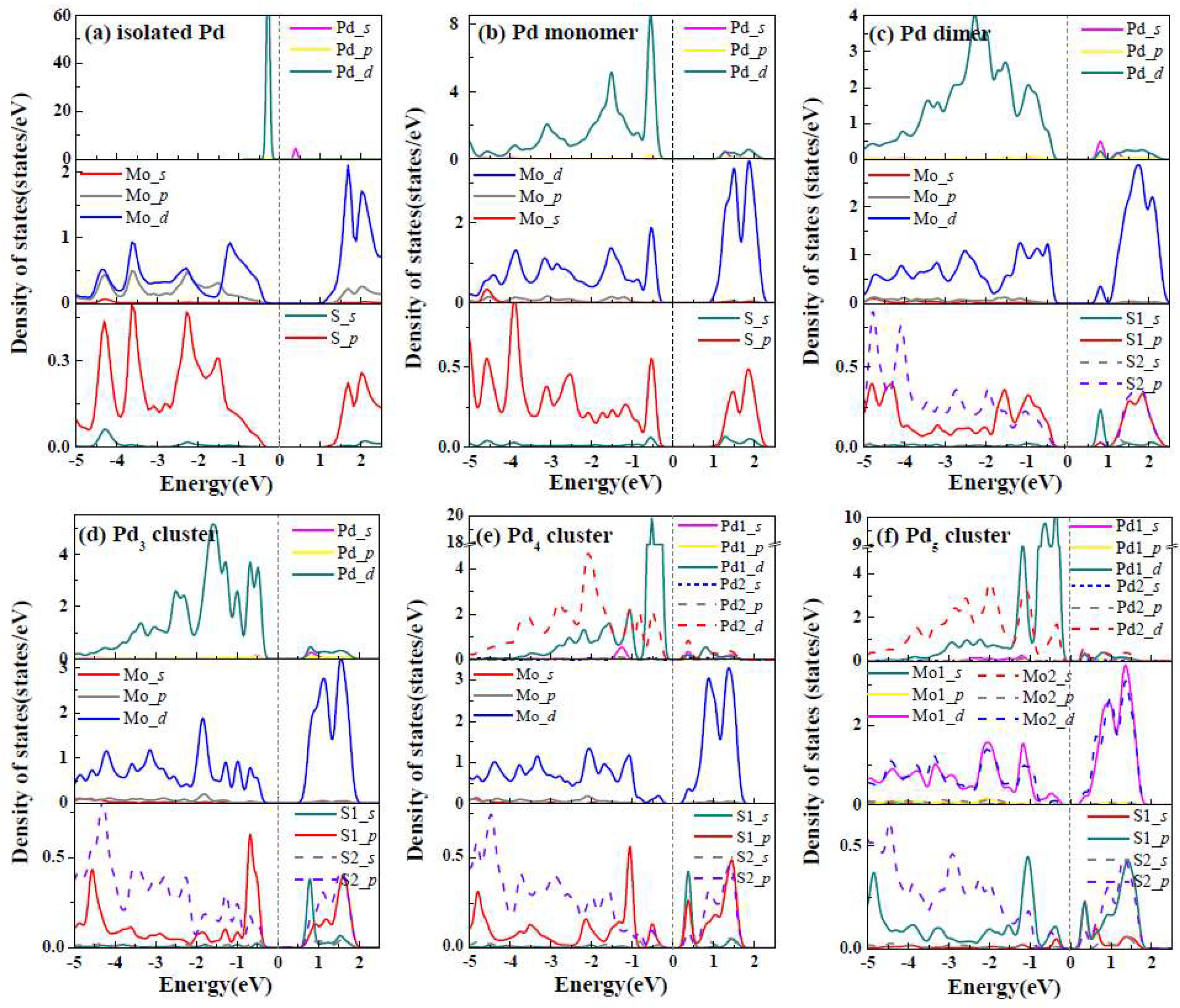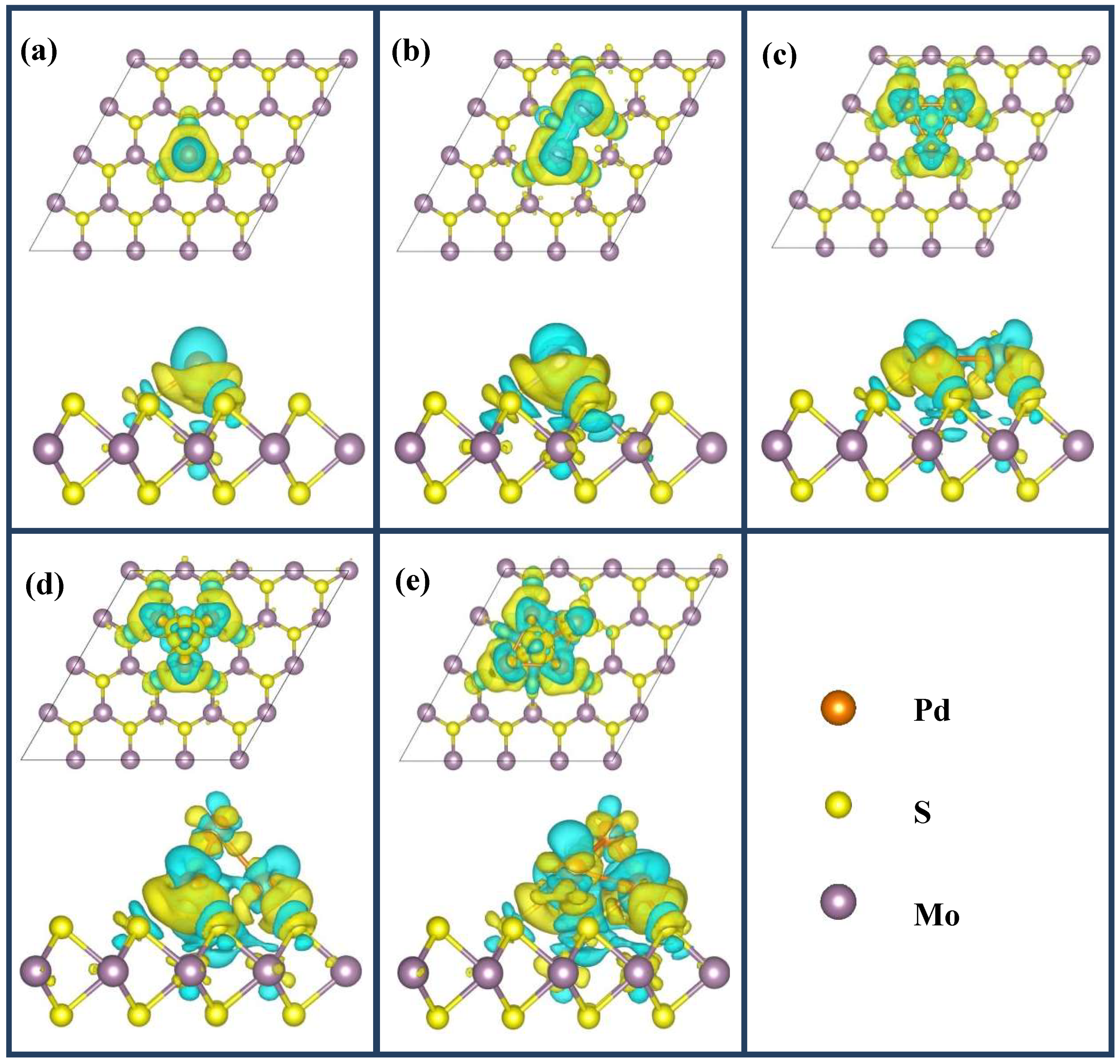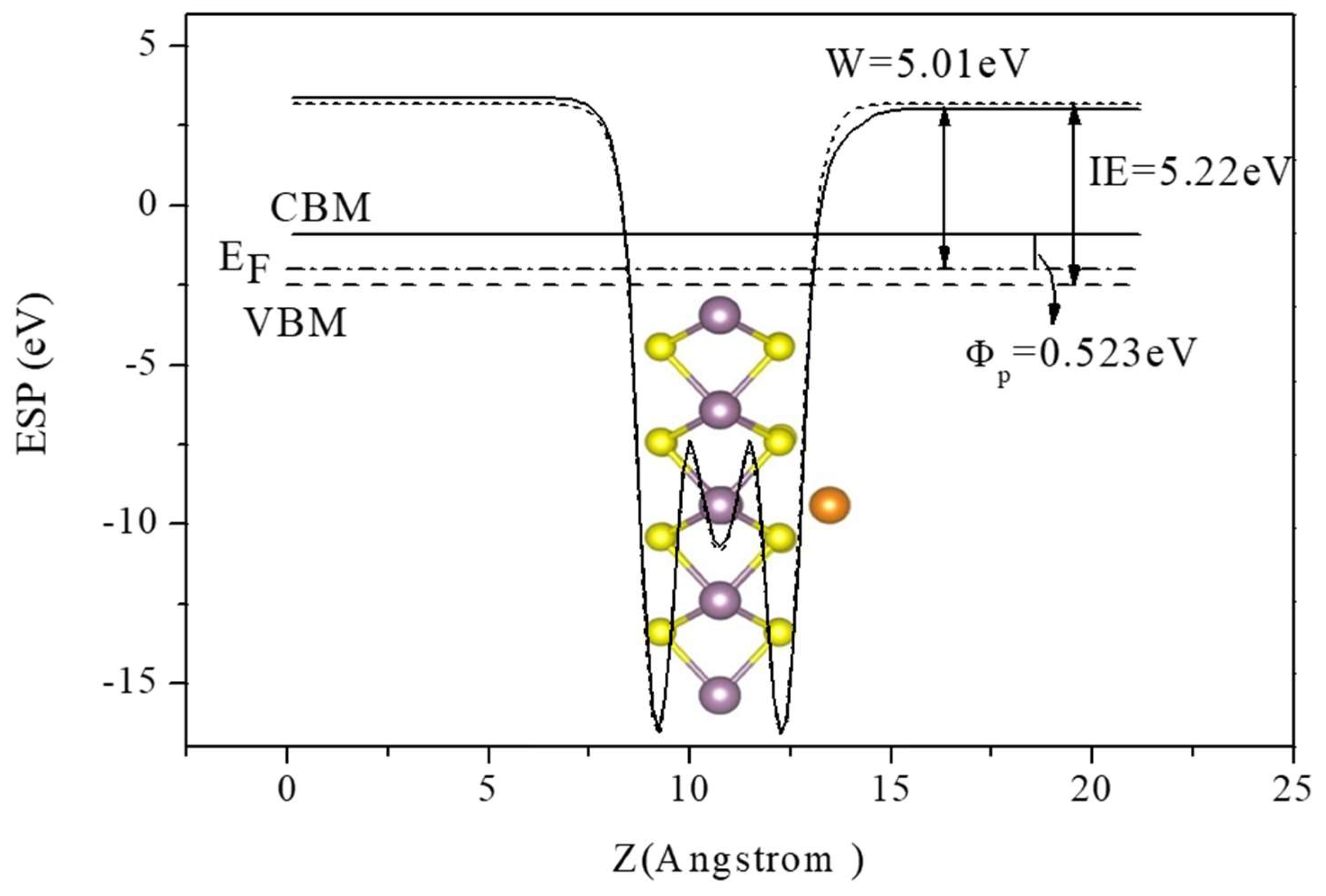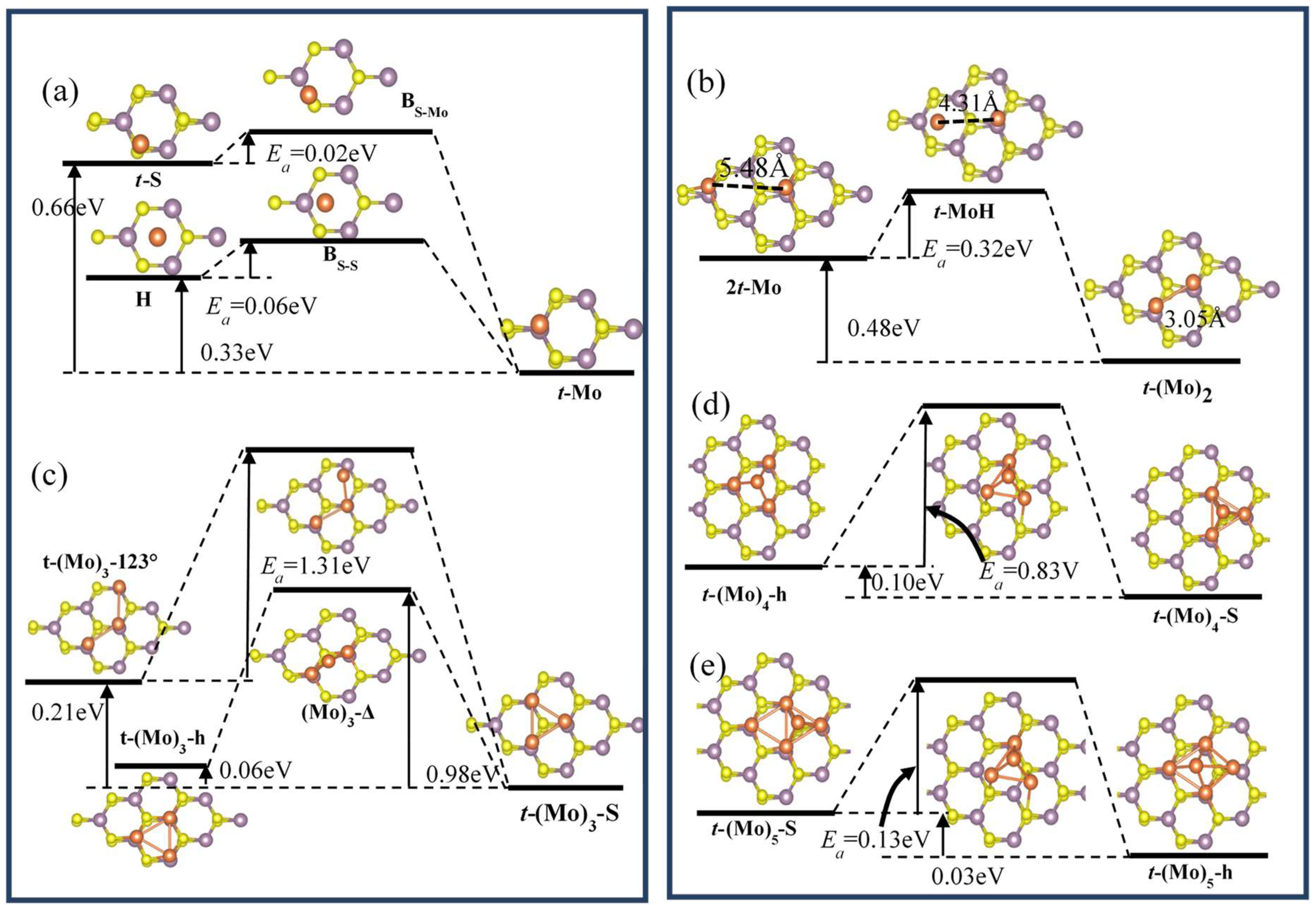3.1. Geometries and Stabilities for Pdn (n = 1–5) Adsorbed at MoS2 ML
In order to understand the adsorption properties of Pd
n (
n =1–5) clusters and explore the nucleation mechanism and initial growth of Pd nanoparticles on MoS
2 MLs, it is essential to identify the structural and electronic properties of pure MoS
2 ML for comparison.
Figure 1a shows the top and side view of a 4 × 4 supercell of the MoS
2 ML; the calculated results show that the thickness of the MoS
2 ML was 3.14 Å and the bond length of the S–Mo was 2.84 Å, which is consistent with previous studies [
26,
27]. Besides, we calculated the band structures of the MoS
2 ML as shown in
Figure 1b. The calculated results indicate that the MoS
2 ML presented semiconducting character with a direct gap of 1.75 eV at the K point, which is in good agreement with the previous theoretical results of 1.70 eV [
28] and experimental results of 1.80 eV [
29].
We first investigated the geometries and adsorption properties of a single Pd adatom on the MoS
2 ML. For the case of Pd monomer, we considered the binding of Pd on four high-symmetry sites: the hollow (
H) site at the center of a hexagon, the top site directly above Mo (
t-Mo) and S (
t-S
), and the bridge (
BS–S) site at midpoint of the S–S bond, as shown in
Figure 1a. It is known that the larger the adsorption energy
EA, the stronger the interaction between the adsorbate and substrate.
Table 1 lists the structural parameters and adsorption energies for all considered adsorption configurations of Pd monomer adsorbed at the MoS
2 ML. The calculated results show that the
t-Mo site with the adsorption energy of 2.16 eV was the most energetically favorable location, which is consistent with previous studies [
26,
30]. The Pd monomer adsorbed at the
t-S and
H sites were 0.57 and 0.37 eV, respectively, less stable than that of the
t-Mo adsorption configuration. Our calculated results show that Pd monomer located at the
BS-S site finally relaxed to the
t-Mo configuration, which indicates that Pd monomer adsorbed at the
BS-S site was unstable. As summarized in
Table 1, Pd bonds to the surrounding S atoms with a bond length of 2.34, 2.42, and 2.18 Å for the considered adsorption configurations of
t-Mo,
t-S, and
H, respectively, which are comparable with those in two types of PdS
2 monolayer with values of 2.34 and 2.40 Å [
31]. The distances between Pd and nearest neighboring Mo are 2.34, 2.30, and 2.26 Å for three considered configurations, which are mainly resulting from the different adsorption sites. The Pd monomers located at 1.33, 1.59, and 2.19 Å higher than the underlying MoS
2 surface for three considered adsorption configurations, which is consistent with the decreased trend for the calculated adsorption energies from the
t-Mo to
t-S configuration.
We have chosen several initial configurations to search the most stable configurations of Pd
n (
n = 2–5) clusters adsorbed at the MoS
2 ML, which is shown in
Figure 2. The calculated structural parameters and adsorption, binding, and intra-cluster binding energies for the lowest energy configurations of Pd
n (
n = 1–5) adsorbed on the MoS
2 ML are summarized in
Table 2. The most preferential configuration of Pd dimer adsorbed at the MoS
2 ML was that two Pd atoms both adsorbed at the top of Mo, and they were separated by 3.05 Å, which was smaller than the calculated lattice constant of MoS
2 ML, as shown in
Figure 3a. For the cases of Pd
3 cluster adsorbed at MoS
2 ML, the calculated results show that the
t-(Mo)
3-S configuration with the largest adsorption energy of 1.44 eV presents higher stability than the
t-(Mo)
3-h configuration due to the extra binding of S1 atom, in which Pd trimer stands in a plane parallel to the MoS
2 surface. Besides, it is not surprising that the considered
t-(Mo)
3-L with three Pd atoms in a line adsorbed at the top of Mo is higher in energy than the triangular islands because of the decrease in the number of intra Pd–Pd bonds. The average bond length of Pd–Pd and the height of Pd
3 cluster above the MoS
2 surface are 2.94 and 1.49 Å, respectively. The Δ–(Mo)
3 structure where two Pd atoms were located at the
t-Mo sites and the third one was located at the bridge site of the two Pd atoms was also considered for the case of the Pd
3 cluster. However, different from the case of Pt
3 on MoS
2 ML, such vertical configuration is unstable as it is about 0.65 eV less stable than the
t-(Mo)
3-S configuration. For the case of Pd tetramers adsorbed at MoS
2 surface, we considered three possible configurations, including aplanar-(Mo)
4 (four Pd atoms located at the
t-Mo site, not shown here), pyramid-like
t-(Mo)
4-h, and
t-(Mo)
4-S configurations. The computed results show that the most favorable structure is
t-(Mo)
4-h (shown in
Figure 2c) for Pd tetramer adsorbed at the MoS
2 ML, implying the growth mechanism transitions from a two-dimensional (2D) to a three-dimensional (3D) mode from the formation of Pd
4 cluster. Based on the most stable configuration of Pd
4 tetramers supported by the MoS
2 ML, we considered three initial geometries for Pd pentamer. After full structural optimization, the most stable structure was asquare pyramid
t-(Mo)
5, shown in
Figure 2d, which could be obtained by adding one additional Pd atom adsorbed at a neighboring
t-Mo site with respect to the
t-Pd
4-h configuration.
From the above calculations, it is clear that the palladium clusters are energetically preferred to lying planar to the surface for the initial growth of Pdn clusters on MoS2 ML at very low coverage (from Pd1 to Pd3). With increasing the coverage, the Pdn clusters immediately form islands clusters, such that the morphology of t-(Mo)4-h and t-(Mo)5-h are the most stable configurations for Pd tetramer and pentamer, respectively. Therefore, under situations dominated by the thermodynamic effects, the clusters with planar structures may be expected to only appear in the very early growth stage and the size of these clusters are very small (e.g., Pd2 and Pd3), which is immediately followed by the Vomler–Weber growth mechanism.
In our previous study on the initial growth of Pd
n/NiAl(110) [
32], we reported that small-size Pd
n (
n = 1–5) clusters favor the planar structures on the NiAl(110) surface, which was explained by the stronger interaction between Pd
n clusters and NiAl substrate than the interaction among Pd adatoms in clusters. In order to explore the modulation of MoS
2 substrate on the growth mechanism of Pd
n clusters, it is crucial to understand the evolutions of the metal–metal and metal–slab interactions with the increase of cluster size. We summarize the adsorption, binding, and intra-cluster binding energies as well as structural parameters for the most stable structures of Pd
n (
n = 1–5) adsorbed on the MoS
2 ML in
Table 2. It was found that the adsorption energies,
EA, decreased from 2.16 to 0.86 eV when the Pd coverage increased from Pd
1 to Pd
5 clusters, which indicates the strength of the interactions between the Pd
n (
n = 1–5) clusters and MoS
2 gradually weakened. The results are reasonable since the height of Pd clusters above MoS
2 increases from Pd monomer to Pd
3 cluster with planar structures. For the case of pyramid-like structures, Pd
5 waslocated at 0.03 Å higher than that of Pd
4 above the MoS
2 ML as listed in
Table 2; however, the additional Pd–Pd bonds weakened the Pd–S bonds resulting in less stability of Pd
5 cluster. The binding energy,
EB, that reflects the relative stability of the Pd
n (
n = 1–5)/MoS
2 system, gradually increased from 2.21 eV for Pd
2 to 2.38 eV for Pd
5, which indicates the relative stability of larger Pd clusters adsorbed at the MoS
2 ML was higher than that of smaller ones. With the increase of Pd coverage (from Pd
2 to Pd
5), the intra-cluster binding energy
EIB rapidly increased from 0.37 to 1.52 eV, which suggests that the interaction among the Pd adatoms in the Pd
5 cluster was stronger than those of smaller ones. Besides, it was noticeable that the
EIB was larger than
EA for Pd
4 and Pd
5, which indicated that intermetallic Pd–Pd bonds in clusters were stronger than the bonds between Pd and surrounding S or Mo. This can be used to explain the fact that the most stable structures for Pd
4 and Pd
5 started to appear around the three-dimensional structures with smaller Pd–Pd bond lengths (about 2.63 Å). Compared with a previous study on Pd
n cluster/graphene [
33], in which size-selected monodisperse nanoclusters were identified by scanning tunneling microscopy, Pd
n clusters supported by MoS
2 are more stable due to larger binding energies and shorter distance between Pd
n and MoS
2 substrate, which indicated that the MoS
2 ML was inert and an ideal template for deposition of the metal NPs to some extent.
3.2. Electronic Properties of Pdn (n=1–5)/MoS2 Monolayer
In order to better understand and control how the deposition of Pd clusters affect the structure and electronic properties of MoS
2, we calculated the density of states (DOS) of MoS
2 ML with and without the adsorption of Pd
n (
n = 1–5) clusters shown in
Figure 3. It is clear that the 4
d states of isolated Pd atom was very sharp at 0.35eV, while 4
d states of Mo hybrids with the 3
p states of neighboring S atoms for pure MoS
2 ML. Upon the adsorption of Pd monomer on MoS
2 (
Figure 3b), the band gap decreased to about 1.09 eV, which is mainly attributed to the hybridization of the 4
d states of Pd atoms with 4
d states of underlying Mo and 3
p states of the nearest surrounding S at 0.50 eV below Fermi level. For the case of Pd dimmer adsorbed at MoS
2 ML (
Figure 3c), a gap state emerged at the 0.80 eV above the Fermi level, which resulted from the hybridizations between Pd atoms and the nearest-neighboring Mo and S atoms. For the case of Pd
3 cluster, the partial density of states (PDOS) of three Pd adtoms were similar due to the identical atomic environments as shown in
Figure 3d. We found that Pd adatoms hybridize more strongly with the S atom located at the hollow site of the Pd trimer (labeled by S1 in
Figure 2b) than the nearest-surrounding S atoms (labeled by S2 in
Figure 2b) at −0.80 eV. For the case of the Pd
4 and Pd
5 clusters with pyramid-like geometries (
Figure 3e–f), the DOS of the topmost Pd adatoms labeled as Pd
4-1 and Pd
5-1 (located at the second layer of clusters) in
Figure 2c were relatively localized compared with those of the underlying Pd (labeled by Pd
4-2 and Pd
5-2 in
Figure 2d, which were located at the first layer of the clusters), which indicated that the electronic properties of the topmost Pd were hardly affected by the MoS
2 substrate. The calculated results also show that the gap state located above the
EF was shifting close to 0 eV from the Pd
3 to Pd
5 clusters, which caused the band gap to decrease from 0.70 eV of the Pd
3/MoS
2 system to 0.19 eV of the Pd
5/MoS
2 system.
3.3. Charge Redistribution and Work Functions
In order to analyze the character of bonds between adsorbates and MoS
2 substrate as well as the charge redistribution of MoS
2 upon the adsorption of Pd clusters, we calculated and analyzed the electron density difference, which is defined as
, where
is the charge density of total system,
and
are the charge densities of pristine MoS
2 ML and the free-floating Pd clusters in the frozen geometry they adopted on the Pd
n/MoS
2 system, respectively.
Figure 4 shows the corresponding difference in electron densities for all considered optimized stable configurations, yellow and blue region represent charge accumulation and charge loss, respectively. As shown in
Figure 4, the charge redistributions upon the deposition of Pd
n cluster mainly involved Pd clusters and surrounding S and Mo atoms, which imply strong charge transfers between the Pd
n (
n = 1–5) clusters and MoS
2 substrate. It is clear that there was strong electron density accumulation between Pd atoms and nearest-neighboring S atoms, which indicates that the bonds between Pd adatoms and surface S atoms present a covalent bond with partial ionic features. There are depletion regions close to the Pd atoms along the bond directions of Pd–S, which can be explained by the stronger electronegativity of S than Pd. For the cases of Pd
2 and Pd
3 clusters, the Pd atoms highly hybrid with the center-S (labeled as S1 in
Figure 2). It is also observed that the characteristics of Pd–Pd bond remain strong metallic upon Pd clusters supported by MoS
2 ML. However, for the cases of the Pd
4 and Pd
5 clusters (
Figure 4d,e), it is surprising that strong electron density accumulation was found for the topmost Pd atoms (such as Pd
4-1 and Pd
5-1), which indicates that the top Pd atoms directly receive charge from the underling Pd layers rather than losing charge to the MoS
2 substrate.
To further give a detailed insight into the charge transfer, we also calculated the atomic populations for the most favorable configurations of Pd clusters adsorbed at the MoS
2 ML, as summarized in
Table 3. Upon Pd adatoms adsorbed at the
t-Mo site, Pd adatoms lost about 0.26e to the MoS
2 ML by Bader analysis, which suggested Pd–S bonds exhibited a relatively significant ionic bonding component, as illustrated by the substantial charge density difference between Pd and neighboring S atoms shown in
Figure 3a. Similarly, Pd adatoms in dimer and trimer averagely contributed about 0.20 and 0.18e to the MoS
2 ML, respectively. However, in the cases of Pd
4 and Pd
5 clusters with pyramid-like geometry, Pd atoms in the first layer and second layer of the clusters behave in a different way. The Pd atoms in the second layer of the cluster (Pd
4-1 and Pd
5-1) obtained charge, while the Pd atoms of the first layer lost charge. This result is in good agreement with the phenomenon of charge accumulation near the topmost Pd atoms as shown in
Figure 4d,e. Therefore, it is not surprising that the MoS
2 slabs obtained less charge from Pd
4 and Pd
5 clusters than that of the Pd
3 cluster.
Figure 5 shows the in-plane averaged electrostatic potential (ESP) for the MoS
2 surface with Pd monomer (solid line) and that of the pristine MoS
2 surface (dotted line), respectively. The same were done for other Pd clusters, which are not shown here. Ionization energy (IE), defined as the energy difference between the vacuum level and valence band maximum (VBM), was determined to be 5.48 eV for the clean MoS
2 ML. Upon the Pd
n (
n = 1–5) clusters adsorption, the increase of ionization energy (Δ
I) was observed, which can be quantificationally given by the energy difference between the vacuum levels. In addition, the work function is described as the following equation:
W =
Evac−
EF, where
Evac is the electrostatic potential in the vacuum region of the adsorbate side of the MoS
2 surface, while
EF refers to Fermi energy. The work function of pristine the MoS
2 ML was estimated to be 5.26 eV, which is slightly higher than the experimental result of 5.03 eV [
34].
As indicated in
Figure 5, we also defined the energy difference between Fermi level (
EF) and the CBM of the MoS
2 ML as
p-SBH (
ΦP) for convenience, although the well-defined Schottky barrier contact had not formed yet in our considered initial growth stage of Pd clusters. In
Table 4 we summarized the calculated work function (W),
p-SBH (
ΦP), dipole moments (
Di), and the variation of ionization energy (Δ
I) for the adsorption of Pd clusters. It became clear that the increasing of Pd coverage leads to decreases in the work function from 5.01 eV of Pd adatom to 4.38 eV of Pd
5 cluster, which may result from the larger amount of CT from Pd
n cluster to MoS
2 as listed in
Table 3. We think the variations of
p-SBH are mainly attributed to the gap states caused by Pd adatoms (as shown in PDOS in
Figure 3) and the partial charge transfer from 1stlayers to the second layer Pd atoms. The trend for the variations of ionization energy is obvious: as the cluster size increases (from Pd
1 to Pd
5), Δ
I reduces rapidly, while Δ
I rises in the initial growth stage of Ni clusters supported by MgO (001) [
35]. In addition, the dipole moments (
Di) were calculated by the product of transfer charge and the distance of adsorbate-substrate. The calculated dipole moments of Pd
n/MoS
2 were not in a monotonic variation, which is different from the monotonic increase of
Di with the increase of Ni coverage on MgO (001).We think that the main reason for these distinct phenomena of the two systems is that the Pd
n clusters injected electrons into the VBM of the MoS
2 substrate while the Ni
n clusters extracted electrons from the MgO (001) surface. Besides, Pd adatom, Pd
2, and Pd
3 clusters prefer the planar structures as discussed above, and there is only the interface dipole contribution in such systems. For the cases of Pd
4 and Pd
5 clusters with pyramid-like structures, intra-cluster dipoles due to the CT between the topmost layer and the lower part of the cluster also contribute to the dipole moments. Since these two dipoles have opposite directions, the dipole interactions between Pd
4 or Pd
5 clusters and MoS
2 substrate can be cancelled to some extent.
Previous studies have confirmed that the coverage-dependent depolarization effects play a non-negligible role in metal–organic interfaces [
36,
37,
38]. In order to get insight into the coverage-dependent depolarization effects caused by the interaction between the adjacent supercells, we also used a (6 × 6) supercell to study the adsorption of Pd
n clusters at the MoS
2 substrate. We found that the CT and work function of Pd
n (
n = 1–3)/MoS
2 systems have no significant change, while the variation on CT and work function for Pd
4/MoS
2 and Pd
5/MoS
2 were less than 0.04 and 0.01 eV, respectively. Therefore, the interactions between Pd
n (
n = 1–5) clusters within adjacent supercells is ignorable, and thus the coverage-dependent depolarization effects can be ignored in Pd
n/MoS
2 considered in this work. The discrepancy between metal–organic interfaces [
36,
37,
38] and Pd
n/MoS
2 interface maybe explained by different interactions between adsorbates and substrate and different sizes of adsorbates, such as non-specific bonding between organic molecules and substrates versus the covalent Pd–S chemical bonds in our study, and larger diameters of organic molecules than that of metal clusters.
3.4. Diffusion of Pd Clusters on an MoS2 Monolayer
In order to investigate the nucleation mechanism and diffusion properties of Pd clusters on the MoS
2 ML, we analyzed the diffusion and surface mobility of Pd
n (
n = 1–5) clusters on the MoS
2 ML from the most favorable adsorption configurations. We defined the reaction rate
k as the following:
where
is the rate pre-factor, assumed to be irrelevant to the reaction or the hopping events, and
kB and
T are the Boltzmann constant and temperature, respectively. The equation indicated that reaction rate
k is proportional to temperature
T, while
k is inversely related to the activation energy barrier
. In here, the activation energy barrier
is computed from the total energy difference between the initial configuration and the saddle points of the minimum energy pathway between two adsorption configurations. The
k value is usually used to measure the possibility of nucleation and diffusion by overcoming the energy barrier at the low Pd coverage. The energy diagrams of Pd
n (
n = 1–5) clusters nucleated or diffused on the MoS
2 ML are shown in
Figure 6. As shown in
Figure 6a, the calculated activation energies were 0.12 and 0.02 eV for the on-surface diffusion of Pd monomer along the two paths of
t-S→
t-Mo and H→
t-Mo, respectively, which indicates the diffusion of Pd monomer on the MoS
2 surface show remarkably anisotropy. The activation energy barrier was much smaller than the value of 0.34eV for Pd monomer diffusion on MgO (100) via single atom hops between oxygen sites [
39], implying the Pd adatom on the MoS
2 surface was mobile during the in situ growth by deposition. According to Equation (4), the number of hopping events per second between two
TMo sites was estimated to be 10
3 s
−1 along the Mo–H–Mo path and 10 s
−1 along the Mo–S–Mo path at room temperature, respectively. The results indicated that the Pd adatoms are more likely to be mobile for coarsening and growth of large clusters rather than a random dispersion during the deposition. We also found that a newly deposited Pd atom prefers to bond to existing Pd adatoms located at
t-Mo sites by possible diffusion, which is illustrated in
Figure 6b. The energy barrier for the attachment of a Pd adatom to an existing Pd monomer to form Pd dimer is 0.32 eV, and the process is downhill by 0.48 eV. In other words, the deposited Pd adatoms are expected to bond to Pd monomer adsorbed at MoS
2 rather than adsorb at a remote site. According to Equation (4), the higher the reaction temperature is, the easier the reaction occurs. For instance, the reaction rates
k for the nucleation of Pd dimer from two Pd adatoms on MoS
2 surface will increase about 140 and 485 times compared to that of room temperature (RT)under
T = 500 and 600 K, respectively.
The three flat trimers
t-(Mo)3-123°,
t-(Mo)
3-h, and
t-(Mo)
3-S shown in
Figure 6b are easily accessible during metal deposition, which can be formed by the low-energy diffusion of Pd monomer on MoS
2 surfaces to reach a Pd dimer. As shown in
Figure 6b, although the total energies of the initial states of
t-(Mo)3-123° and
t-(Mo)
3-h configurations were about 0.21 and 0.06 eV higher than that of the most stable configuration of
t-(Mo)
3-S due to the extra binding of the S1 atom, the energy barriers for transforming the flat
t-(Mo)3-123° and
t-(Mo)
3-h configurations to
t-(Mo)
3-S were 1.31 and 0.92 eV, while the reverse processes were examined to surmount the energy barriers of 1.52 and 0.98 eV, respectively. We found that the transition state from
t-(Mo)
3-h to
t-(Mo)
3-S was Δ-(Mo)
3, which was0.96 and 0.98 eV energetically higher than that of the initial and final states. However, the identical Δ-(Mo)
3 configuration was predicted as the intermediate state with the lowest energy during the transformation between
t-(Mo)
3-h and
t-(Mo)
3-S configurations of Pt
3 clusters on MoS
2 ML as reported in Reference [
14]. Such discrepancy may be due to the larger cohesive energy of Pt than that of Pd, which makes it is more likely to form islands for Pt NPs than Pd NPs.
We have considered various possible structures of palladium tetramer
, which is formed by the simple extension from
t-(Mo)
3-S and
t-(Mo)
3-h via the attachment of Pd monomer to Pd
3 clusters. The computed results show three-dimensional
t-(Mo)
4-S was favored over
t-(Mo)
4-h only by 0.10 eV in total energy, both of which can be nucleated on the MoS
2 ML. It was clearly observed that transition from
t-(Mo)
4-h to
t-(Mo)
4-S should overcome the energy barrier of 0.83 eV, which is twice that of the transformation barrier of Pt
4 clusters with the identical structures on the MoS
2 ML [
14]. It indicated that the diffusion of Pt
4 clusters was likely to be much more accessible compared with Pd
4 clusters on MoS
2 MLs. Similarly, the most preferable configuration can be accessed from configurations
t-(Mo
4)-h and
t-(Mo
4)-S by deposition of new Pd atoms or diffusion of Pd monomers to the nearest-neighboring
TMo site. The two pyramid-like Pd
5 clusters labeled as
t-(Mo)
5-h and
t-(Mo)
5-S are shown in
Figure 6e, respectively, which were found to be stable and have a slight energy difference of about 0.03 eV. The computed results show that the transformation of
t-(Mo)
5-h and
t-(Mo)
5-S was almost barrier less with
Ea about 0.13 eV.
The diffusion of Pd atoms from the topmost site of a pyramid-like structure to the MoS
2 substrate was a key factor to decide the growth mode of the Pd
n cluster on the MoS
2 monolayer. Therefore, we also calculated the diffusion behaviors of Pd atoms from topmost sites of Pd
4 and Pd
5 clusters to the MoS
2 substrate. The calculated results show the topmost Pd atoms moving to the nearest-neighboring
t-Mo sites of the MoS
2 substrate needed to overcome the energy barriers of 0.73 and 1.13 eV for Pd
4/MoS
2 and Pd
5/MoS
2 systems, respectively. The relative high energy barriers imply that the Pd atoms prefer to form a sheet-supported metal nanotemplate on MoS
2 in the initial growth stage, which is in conformity with the previous experimental study reported by Gong et al. [
40] that Pd forms a uniform contact by physical vapor deposited on MoS
2 monolayers.
